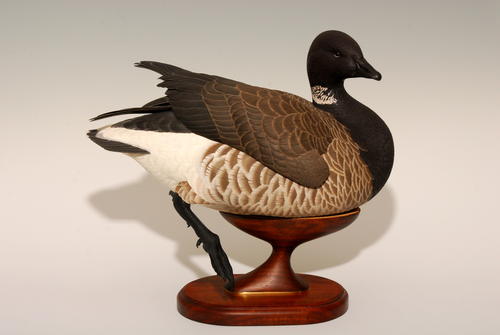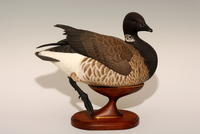Bobinchecks Birds
A retired shop teacher turns to bird carving.

Rick Bobincheck’s Atlantic brant won second in World Pairs at the 2005 Ward World Championship.
It’s always interesting to learn how various carvers came to the art form of wildfowl carving. Some began as hunters with a desire to create their own working decoys. Others came from an art background as sculptors and some sought to capture in wood the beauty and variety of the birds they loved to study. For many carvers, it was an extension of their love for woodworking. Rick Bobincheck falls mostly in this last category.
For 35 years Rick taught what most of us know as “shop” courses at Laurel Highlands Middle School in Uniontown, Pennsylvania. “Teaching wood shop, metal shop, and mechanical drawing taught me to use my hands and gave me an understanding of the physical and construction properties of wood and metal,” says Rick. An examination of his work also reveals that Rick learned to be a meticulous craftsman with an eye toward biologically accurate and skillfully constructed decorative birds.
Murph Kukurugya, a fellow teacher and friend, introduced Rick to bird carving. Murph’s father had carved songbirds, and Murph liked to carve waterfowl. Rick became intrigued with the idea of creating a beautiful bird from a simple block of wood. Before long Murph was helping Rick with his first bird, a canvasback hen that he gave to his wife, Denise, for Christmas in 1987. By then he was hooked. Rick says he became a devoted reader of WILDFOWL CARVING MAGAZINE, and pored over the articles to learn various approaches and techniques. “There were few other carvers in my area of southwestern Pennsylvania, so I used the magazine to learn more about carving techniques and enjoyed seeing what other carvers were doing,” he says. “Willie McDonald’s article on band sawing is a classic.” (That two-parter appeared in the Spring and Summer 1992 issues of WILDFOWL CARVING MAGAZINE.) Rick also made regular trips to visit Gary Yoder, and they became close friends. Rick said he learned a great deal just by watching Gary and discussing techniques. (Read more about Gary and his work in the Fall 2009 issue.)
Eventually, Rick wanted to go to the next level— competition—as a way to compare his work with that of other carvers and get advice from fellow competitors. “There might be one aspect of a carving you totally don’t see, don’t recognize, until someone at the competition points it out and says, ‘You could have done it this way. . . ,’” he says. As with many carvers, competition turned into a great learning experience. The first show he entered was the Western Pennsylvania Carving Competition sponsored by the Loyalhanna Watershed Association in Ligonier, Pennsylvania. He entered a green-winged teal and won honorable mention in novice life-style floating waterfowl. Today he competes primarily at Ohio Decoy Collectors and Carvers show (now held in Strongsville) and the Ward World Championship competition in Ocean City, Maryland. He quickly advanced to the International Wildfowl Carvers Association Open level and moved into the Masters class at the World competition. In 2007 he won third in Masters with a drake redhead. He says his most prestigious achievement came two years earlier, when he won Second in World Pairs with an Atlantic brant, a full-bodied carving that included feet. Rick says he never imagined he would be acknowledged on the stage at the Ward along with carvers whose work he had admired for years. “It was a humbling experience.”
One carving he’s especially fond of is a drake pintail that won first best of show in the open (now the advanced) division at the Ward in 2001. “The pintail, being such a regal looking bird with its splayed tertials and long tail, offered challenges that I never faced before,” Rick says. “Carving some lift and vertical dimension to the tertial group had a very pleasing outcome.”
After retirement, when he had more time to devote to carving, Rick became more comfortable with his carving techniques and felt he was improving with proportions, colors and painting, and wood burning detail. All along, his goal was to produce a biologically accurate and aesthetically attractive decorative carving that captures the beauty and character of the bird and contributes to the decor of the room.
While his first pieces were mostly ducks, Rick now enjoys carving songbirds as well. Among the species he’s completed are an indigo bunting, cardinal, yellow-billed cuckoo, catbird, and red-winged blackbird. Songbirds, he says, do offer different challenges. Not only do you have to construct feet and habitat, the actual bird provides a much smaller platform than a duck does. In addition, in most non-floating carving compositions the artist is trying to use everything in the piece to tell a story. Before starting, the carver must understand the bird’s attitude and its relationship with any other birds or animals in the piece. “Knowledge of your subject is imperative and personally being drawn to one or the other is a choice we carvers all make.”
Currently, he’s working on a black duck but he plans to do a bluebird next. Rick likes to increase his knowledge of his subjects by watching them in the wild. His wife, Denise, is an avid birdwatcher, and Rick says she orders so many mealworms the mail carrier thinks they run a bait shop. “My wife’s passion in caring for her songbirds leaves no day without many minutes of discussion of the exploits of her feathered friends outside,” he says. “Her interests keep my interests in songbird carving alive and well.”
A good example of the great care and extensive planning Rick brings to each piece is a novel technique he developed to accurately set eyes (see below). Family obligations have kept Rick busy for the recent seven years, but he now hopes to become more active in competition. Look for him at ODCCA in Strongsville and the Ward World Championships in Ocean City. When you do, take a close look at those perfectly set eyes.
For more on Bobincheck's painting techniques, check out our featurette here.
For more on Bobincheck's perfectly set eyes, please click here.
Read NextDemonstration: Carver's Block
YOUR RECENTLY VIEWED ARTICLES
Free tutorials, expert tips, exclusive partner offers, and more straight to your inbox!
RickC56
Jun 02, 2019
So is this article in an issue. And the techniques with links to are they in an issue or issues?
Report Inappropriate Comment
Are you sure you would like to report this comment? It will be flagged for our moderators to take action.
Thank you for taking the time to improve the content on our site.



